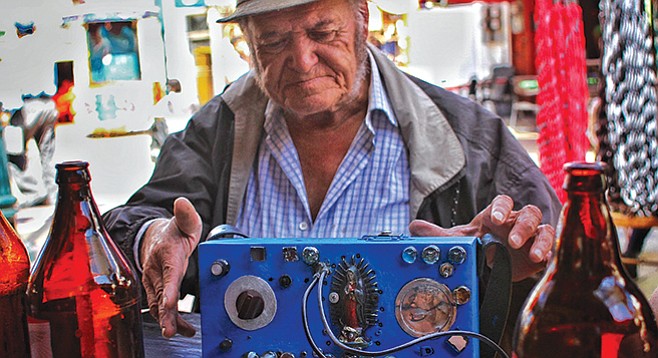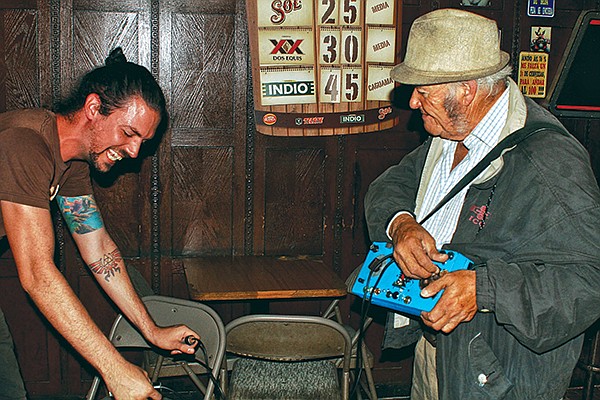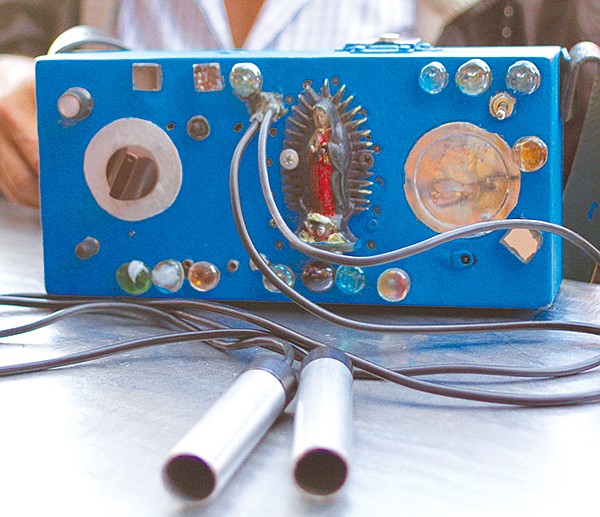 Facebook
Facebook
 X
X
 Instagram
Instagram
 TikTok
TikTok
 Youtube
Youtube

Clickety-clink-clack. Toques! Toques!
A man wearing polished shoes, a zoot suit, and a fancy hat walks through a bar with a decorated electric box attached to his hip. Two metal tubes that he smashes together like Luther, the leader of the Rogues, who calls the Warriors to come out and play in the 1979 cult film.
But instead this man yells, “Toques! Toques!” (Shocks! Shocks!) Clickety-clank-click, the man walks by all the patrons but no one wants to pay to be zapped by his electric box. He leaves the establishment and into the next one.
“They have been around since El Porfiriato,” (early 1900s, so named after then Mexican president Porfirio Díaz). My parents moved to Tijuana in the 1930s and they were already here,” says Henke, an older lady known as La Bruja (the witch) of Tijuana.
I used to see them in dive bars when I first started going out in Tijuana in 2010. The first time I took the challenge was with a stripper I somehow befriended without spending any money. She would go to the maximum voltage and still not flinch. I was the one who let go but stubbornly challenged her again and again to meet the same fate. With each passing year, I have seen fewer electric-shock vendors.
I asked everywhere to find out when and how selling electric shocks in the streets started. My research took me to the city’s historical archives, where they told me to ask at COLEF (Colegio de la Frontera). Ismael Ruiz of COLEF took a day to respond to my inquiry, then suggested I contact a professor at UABC (Universidad Autónoma de Baja California).
“Like almost every street vendor in the city, the electric-shock vendors come from Mexico City,” comments professor Soto Ferrel via email. “There is not much information written about them, but they have been out late at night for decades. They all seemed to be sober, but you could see in their eyes all the late nights they have survived selling electric shocks. I am not sure if they are still around.
“You’ll find the workers in cantinas, popular pool halls, pulquerías, and dive bars,” continued Ferrel. “It is tied to machismo culture, especially when under the influence of alcohol. It’s a way to display your manhood by showing how much voltage you can take. But there’s also the possibility, that supposedly, the electric shock will allow you to keep drinking even more. But of course, when you are at a table with friends, whoever doesn’t participate in the game, or whoever lets go is declared the loser and has to buy the drinks. The loser is also considered ‘delicate’ because he can’t take the pain — no aguanta nada.
“It used to be a popular to challenge tourists in cantinas,” Ferrel continued. “The idea was to play dumb when they asked in English to lower the voltage and deliberately bring it up, it had a sadistic nature. Of course if the group had interracial diversity, even better if it included women, the shocks salesmen had a chance to enjoy hilarity for a while.”
“The shocks salesmen (‘vendedor de toques’), is a play on words with marijuana salesmen (and many times they are associated with their use). They go on from table to table with an ambiguous verbal offer from table to table.”
Professor Soto is right. When asking for vendedores de toques in several dive bars and on the street, everyone thought I was looking for drugs. After explaining the mix-up, they usually told me to wait for them at a bar, but no one would show up.
“The little boxes, generally made out of wood, are very decorated, with brass, mirrors, velvet, stamps of La Guadalupana or Saint Judas Tadeo (Jude the Apostle), so the ‘on’ button would look flashy,” Soto continued. “The salesmen that I remember were guys that had the appearance of boxers, almost always with a dress jacket, a bit like dandies, sort of pachucos. Usually with a hat or beret and very polished shoes. It’s curious...I remember them never being drunk or using foul language. The opposite, very serious. Very professional, though the scars of the long nights were evident.
“I haven’t seen any of them lately, and I fear...that they have disappeared when tourism declined. Or maybe they started disappearing because of municipal laws, particularly the obsessive era PANistas who wanted to control street vendors. It’s a shame that a city with folkloric characters such as them have been lost with the passage of time.”
I told my Tijuana friends that I was looking for information but not even history students know how this started. Tourists, meanwhile, are baffled by the idea of paying someone to give you electric shocks. But some get into the spirit.
“What the hell, mate, let’s go for it.” A trio of Aussies I led on a tour wanted to try everything they could in Tijuana. Groups usually hold hands in a circle, the circle closes with the electric box, each metal tube is held by a different person at the end of the circle. The pain at first is barely noticeable, but it gradually increases as the vendor increases the voltage. One of the Australians let go of my hand, “Aye mate, that effin’ hurts.”

We tried again. Same guy let go when the knob reached 7. “I can’t do it, I can’t! I still feel the electric pulses on my arm.”
After letting go, your arms feel tense from the shocks. The nerve tension disappears after a few minutes...or after a few drinks.
“I have been doing it for three years. I used to take pictures, but there is no money in that anymore,” a shock salesman told me at around 2 a.m. in one of the most popular strip clubs while I was in a middle of a bachelor-party tour. He was an older gentleman with a little white hair slicked back with gel, semi-hidden under a top hat. The man showed off his flabby skin with pride from getting electrocuted hundreds of times. He said there was no long-term damage. He carried a box decorated with bright blue and yellow mosaics.
I told my tour group about getting electrocuted and asked the seller how much. “For you five, I will do it for $2. It is usually $1 per person, but I’ll give you a discount.” My group consisted of an Italian, an American, and two Indian guys (one of the Indian guys had a sign that read, “I am fucking getting married”). We were already plenty drunk from tequila shots, so we held hands in a circle and waited to get shocked. Both times the one to let go before it even hit half power was the one getting married.

I have stopped several vendors to ask them how they started and for more information, but they are reluctant to tell me much except that they are the best ones at it. Most said they have been doing it for over a decade.
One night, at around 3 a.m., my friend Chad and I were at a bar. We were not particularly looking for shock salesmen, but we heard the clickety-clack — “Toques, toques!” Chad stared at me, drunk, and took out his cell phone and started recording.
“Juan de Jesus,” replied the salesman when I asked his name as he shocked me. “I’ve been doing this for around seven years. I used to sell cigarettes and knick-knacks, but I’d rather do this.”
“Vengo de Toluca,” Juan said, mentioning the state he is from...though it was obvious. His box was painted red and decorated with the Diablos, Toluca’s soccer team. My conversation deviated to talking about soccer as the power of the shocks increased. When he was around level 8, all I could say was Gallos Blancos is a better team while he said Los Diablos del Toluca were. Juan kept increasing the voltage, to which I responded with a series of curse words over and over.
I was trying to let go of the metal rods, almost falling to my knees when reaching maximum level. The metal rods felt like they were attached to my hand and I couldn’t get rid of them, until suddenly… no more pain.
“I make around 200 to 1000 pesos [$18–$90) a night. It depends: a very good night I’ll make more than 2000 pesos, but those are very rare nowadays.”
I gave Juan 100 pesos for his services, stretched my arms, and rubbed my elbows. I felt the electricity still flowing through my veins.


Clickety-clink-clack. Toques! Toques!
A man wearing polished shoes, a zoot suit, and a fancy hat walks through a bar with a decorated electric box attached to his hip. Two metal tubes that he smashes together like Luther, the leader of the Rogues, who calls the Warriors to come out and play in the 1979 cult film.
But instead this man yells, “Toques! Toques!” (Shocks! Shocks!) Clickety-clank-click, the man walks by all the patrons but no one wants to pay to be zapped by his electric box. He leaves the establishment and into the next one.
“They have been around since El Porfiriato,” (early 1900s, so named after then Mexican president Porfirio Díaz). My parents moved to Tijuana in the 1930s and they were already here,” says Henke, an older lady known as La Bruja (the witch) of Tijuana.
I used to see them in dive bars when I first started going out in Tijuana in 2010. The first time I took the challenge was with a stripper I somehow befriended without spending any money. She would go to the maximum voltage and still not flinch. I was the one who let go but stubbornly challenged her again and again to meet the same fate. With each passing year, I have seen fewer electric-shock vendors.
I asked everywhere to find out when and how selling electric shocks in the streets started. My research took me to the city’s historical archives, where they told me to ask at COLEF (Colegio de la Frontera). Ismael Ruiz of COLEF took a day to respond to my inquiry, then suggested I contact a professor at UABC (Universidad Autónoma de Baja California).
“Like almost every street vendor in the city, the electric-shock vendors come from Mexico City,” comments professor Soto Ferrel via email. “There is not much information written about them, but they have been out late at night for decades. They all seemed to be sober, but you could see in their eyes all the late nights they have survived selling electric shocks. I am not sure if they are still around.
“You’ll find the workers in cantinas, popular pool halls, pulquerías, and dive bars,” continued Ferrel. “It is tied to machismo culture, especially when under the influence of alcohol. It’s a way to display your manhood by showing how much voltage you can take. But there’s also the possibility, that supposedly, the electric shock will allow you to keep drinking even more. But of course, when you are at a table with friends, whoever doesn’t participate in the game, or whoever lets go is declared the loser and has to buy the drinks. The loser is also considered ‘delicate’ because he can’t take the pain — no aguanta nada.
“It used to be a popular to challenge tourists in cantinas,” Ferrel continued. “The idea was to play dumb when they asked in English to lower the voltage and deliberately bring it up, it had a sadistic nature. Of course if the group had interracial diversity, even better if it included women, the shocks salesmen had a chance to enjoy hilarity for a while.”
“The shocks salesmen (‘vendedor de toques’), is a play on words with marijuana salesmen (and many times they are associated with their use). They go on from table to table with an ambiguous verbal offer from table to table.”
Professor Soto is right. When asking for vendedores de toques in several dive bars and on the street, everyone thought I was looking for drugs. After explaining the mix-up, they usually told me to wait for them at a bar, but no one would show up.
“The little boxes, generally made out of wood, are very decorated, with brass, mirrors, velvet, stamps of La Guadalupana or Saint Judas Tadeo (Jude the Apostle), so the ‘on’ button would look flashy,” Soto continued. “The salesmen that I remember were guys that had the appearance of boxers, almost always with a dress jacket, a bit like dandies, sort of pachucos. Usually with a hat or beret and very polished shoes. It’s curious...I remember them never being drunk or using foul language. The opposite, very serious. Very professional, though the scars of the long nights were evident.
“I haven’t seen any of them lately, and I fear...that they have disappeared when tourism declined. Or maybe they started disappearing because of municipal laws, particularly the obsessive era PANistas who wanted to control street vendors. It’s a shame that a city with folkloric characters such as them have been lost with the passage of time.”
I told my Tijuana friends that I was looking for information but not even history students know how this started. Tourists, meanwhile, are baffled by the idea of paying someone to give you electric shocks. But some get into the spirit.
“What the hell, mate, let’s go for it.” A trio of Aussies I led on a tour wanted to try everything they could in Tijuana. Groups usually hold hands in a circle, the circle closes with the electric box, each metal tube is held by a different person at the end of the circle. The pain at first is barely noticeable, but it gradually increases as the vendor increases the voltage. One of the Australians let go of my hand, “Aye mate, that effin’ hurts.”

We tried again. Same guy let go when the knob reached 7. “I can’t do it, I can’t! I still feel the electric pulses on my arm.”
After letting go, your arms feel tense from the shocks. The nerve tension disappears after a few minutes...or after a few drinks.
“I have been doing it for three years. I used to take pictures, but there is no money in that anymore,” a shock salesman told me at around 2 a.m. in one of the most popular strip clubs while I was in a middle of a bachelor-party tour. He was an older gentleman with a little white hair slicked back with gel, semi-hidden under a top hat. The man showed off his flabby skin with pride from getting electrocuted hundreds of times. He said there was no long-term damage. He carried a box decorated with bright blue and yellow mosaics.
I told my tour group about getting electrocuted and asked the seller how much. “For you five, I will do it for $2. It is usually $1 per person, but I’ll give you a discount.” My group consisted of an Italian, an American, and two Indian guys (one of the Indian guys had a sign that read, “I am fucking getting married”). We were already plenty drunk from tequila shots, so we held hands in a circle and waited to get shocked. Both times the one to let go before it even hit half power was the one getting married.

I have stopped several vendors to ask them how they started and for more information, but they are reluctant to tell me much except that they are the best ones at it. Most said they have been doing it for over a decade.
One night, at around 3 a.m., my friend Chad and I were at a bar. We were not particularly looking for shock salesmen, but we heard the clickety-clack — “Toques, toques!” Chad stared at me, drunk, and took out his cell phone and started recording.
“Juan de Jesus,” replied the salesman when I asked his name as he shocked me. “I’ve been doing this for around seven years. I used to sell cigarettes and knick-knacks, but I’d rather do this.”
“Vengo de Toluca,” Juan said, mentioning the state he is from...though it was obvious. His box was painted red and decorated with the Diablos, Toluca’s soccer team. My conversation deviated to talking about soccer as the power of the shocks increased. When he was around level 8, all I could say was Gallos Blancos is a better team while he said Los Diablos del Toluca were. Juan kept increasing the voltage, to which I responded with a series of curse words over and over.
I was trying to let go of the metal rods, almost falling to my knees when reaching maximum level. The metal rods felt like they were attached to my hand and I couldn’t get rid of them, until suddenly… no more pain.
“I make around 200 to 1000 pesos [$18–$90) a night. It depends: a very good night I’ll make more than 2000 pesos, but those are very rare nowadays.”
I gave Juan 100 pesos for his services, stretched my arms, and rubbed my elbows. I felt the electricity still flowing through my veins.
Comments